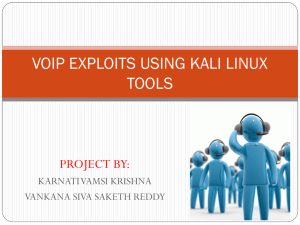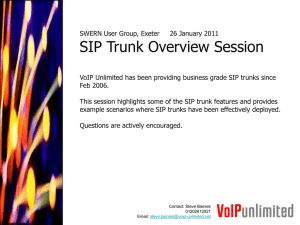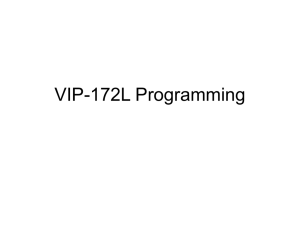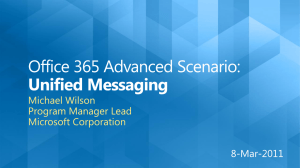SONUS-Avaya Users Group 2012-08
advertisement
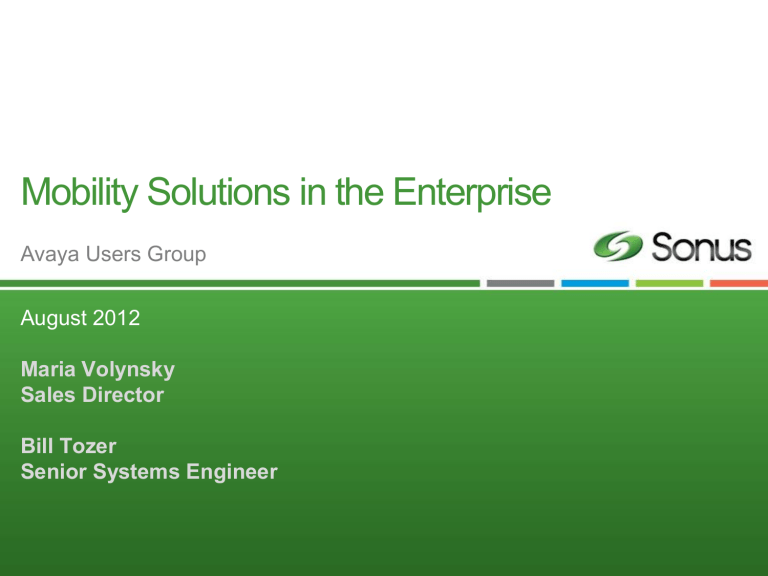
Mobility Solutions in the Enterprise Avaya Users Group August 2012 Maria Volynsky Sales Director Bill Tozer Senior Systems Engineer Agenda Sonus Company Overview Mobility in the Enterprise – What are users looking for? – Benefits to users & organization Fusion Mobility – – – – Overview Key differentiators Other related applications The deep dive, pulling it all together Q&A 2 Sonus Company Overview Sonus Snapshot Market Leadership of VoIP traffic Product Leadership Over in products shipped Innovation Strong Financial Position Employees Engineering Cumulative R&D spend over from inception 4 2011 Revenues of Top Enterprises Rely on Sonus Top US Retail Banks A Top US Airline A Top US Retailer Top US Healthcare and Insurance The Top US Payroll Company $ Largest Public University in California 5 Current Areas of Business 6 Trunking SBC Communication Applications Market Leadership: 600B VoIP minutes annually Tier1 relationships worldwide Hybrid + Standalone Play Successful Large Scale deployments of Voice as a service 5 Year TAM: $12.7B CAGR: -1% 5 Year TAM: $3.8B CAGR: 20% 5 Year TAM: $5.3B CAGR: 10% Enable the evolution to SIP Second Generation SBC Offering, with onboard transcoding Enabling application delivery layer within existing environments Distributed intelligence with centralized routing and policy management Security, Transcoding, Media Services, Call Control and Operaitons Mobility, Click2Connect, Multimerdia Conferencing, Prepaid, Light Contact Centers, Recording Key Benefits of FMC/Enterprise Mobility 7 slide 7 What Does Fixed Mobile Convergence Mean to Your Organization/Users? User Experience • Seamless feature functionality across mobile phone and office PBX extension • Improved coverage of cellular vs WiFi locations • Active directory integration simplifies communications between employees Cost Avoidance • Reduce cellular toll charges with WiFi offload • Support for BYOD integrated with enterprise voice applications (fewer phone sets) • Bring remote workers “into the fold” without additional infrastructure spend Enhanced Productivity and Corporate Compliance • Anytime/anywhere access to employees • Secure provisioning of FMC endpoints • Corporate identity for outbound contact which encourages more direct communications with end customers • Centralized call recording capabilities 8 Enabling an Application Environment The Desired Outcome IM Cloud 10 Applications SMS Mobility Enable Applications without disrupting existing telephony solutions Modality Key Trends Impacting Enterprise Communications Application Management Application Servers Backup and Recovery Systems Dynamic Web Application Development • • • • • • • FMC E-SBC Virtualization SBC, E-SBC Virtualization Hybrid Models Cap & Grow 11 • Presence • Conferencing • Team Collaboration • Social software • CEBP • Security • Privacy • Archive, Search & Retrieval • Data Mgmt • Data Quality • Integration Fusion™ Applications Fusion™ Conferencing Fusion™ Mobility Enterprise mobility smartphone app Carrier-class IP conferencing Fusion™ Click2Connect Sonus Composer Click-to-communicate from 3rd party apps Toolkit for rapid app development Fusion™ MyConnect Fusion™ Attendant Console Intelligent call routing based on user policies Rich collaboration app for tablets Sonus Application Server 12 Key Capabilities 1. Extending PBX features with dual mode capabilities 2. True support for BYOD environment 3. Integrating seamlessly into current PBX environment & future proofing the network 4. Avaya DevConnect Certified 5. Application suite versus point solution 6. Scalability, reliability, hardware independence 7. Customization & business process integration 13 Architecture Centralized SIP Architecture Interconnectivity for voice Trunk consolidation Flattening of dial plans, intra-cluster routing, device registration HQ HQ Branch Branch Remote Worker Branch Enterprise Network Remote Worker Branch Centralized SIP Remote Worker Bus Partner Remote Worker Bus Partner Mobile Worker Mobile Worker Cost Reduction and Administrative Efficiency 15 Traditional Enterprise Architecture Applications Call Recording MS Lync Sametime IVR Site A Contact Center Site B Voice Mail Branch offices Site C HQ Avaya Century Link Long Distance Regional A w/ call center Circuit Switched Enterprise Core IP Network Cisco AT&T Local Regional B Voice PRI Mitel Data 16 Centralized SIP and Dial Plan Site A Centralize SBC DoS, QoS, NAT Carrier HA, 99.999% reliability 10,000 sessions 150 cps Single database Branch offices Site B Site C HQ Avaya SIP Trunk Century Link Long Distance Regional A w/ call center Enterprise SIP Core IP Network SIP Trunk Cisco SBC 5100 AT&T Local Regional B Voice PRI SIP Trunk Mitel Data 17 PSX – Centralized Policy Management Site A Branch offices Site B Site C HQ Avaya SIP Trunk Century Link Long Distance Regional A w/ call center Enterprise SIP Core IP Network SIP Trunk Cisco SBC 5100 AT&T Local Regional B Policy Server SIP Trunk Mitel Data 18 PSX Voice PRI Centralize routing and policy management among all sites Reduce cost of calling between sites and externally Gain complete control over all carrier choices and billing Centralize Dial Plan Application Enablement via SIP Access Trunks Applications Call Recording MS Lync Sametime Site A Contact Center IVR Voice Mail Branch offices HQ Avaya Site C SIP SIP Trunk Century Link Long Distance Regional A w/ call center Site B Enterprise SIP Core IP Network SIP Trunk Cisco SBC 5100 AT&T Local Regional B Policy Server SIP Trunk Mitel Data 19 PSX Voice PRI Centralized SIP Architecture Applications Call Recording MS Lync Sametime Site A Contact Center IVR Voice Mail Branch offices HQ Avaya SIP Trunk Century Link Long Distance Enterprise SIP Core IP Network SBC 5100 AT&T Local Policy Server SIP Trunk Data Sonus Application Server PSX Voice PRI Mitel 20 Site C SIP RegionalSIP A Architecture Centralized w/ call center agnostic SIP Trunk Vendor Scalable SingleCisco database Carrier HA, 99.999% reliability Regional B Site B Centralized SIP and Dial Plan Applications Call Recording MS Lync Sametime Site A Contact Center IVR Voice Mail Branch offices HQ Avaya Site C SIP SIP Trunk Sonus Application Server Regional A w/ call center Site B Century Link Long Distance Enterprise SIP Core IP Network SIP Trunk Cisco SBC 5100 AT&T Local Regional B Policy Server SIP Trunk Mitel Data 21 PSX Voice PRI Application 1: Mobility Fusion™ Mobility Extending Enterprise Services to Mobile Devices Features • Smartphone acts as IP phone inside WiFi networks, traditional mobile outside • Tap to switch between Wi-Fi/3G • iPhone, Android, BlackBerry® • Supports PBX features like call transfer, short number dialing, hold, MWI, multiparty calls on IP and cellular networks Benefits • • • • • 23 Reduce mobile calling, roaming charges Improved productivity for mobile staff Secure one-time use tokens, SRTP Over-the-air provisioning Multivendor PBX support with hosted or on-premises options Adaptation Use Case Managing Call Timing Thresholds Scenario: Extending enterprise call control to mobile users • Inbound calls to an IP PBX are forked to Mobility application Mobility gateway routes the call to Mobility client • Mobility client checks if it has a SIP registration for the user, if not routes the call out to PSTN to connect to user’s mobile device • Typically PSTN call termination will take some time before device starts ringing Inbound Call Mobility Gateway PBX 24 Mobile App SIP Client Mobile App 3G Client SIP Internet PSTN 3G Enabling Applications in Existing Environments INTERNET / PSTN Dedicated Firewall Sonus SBC 5100/5200 Avaya Registered UA CS 1000 CUCM Communication Manager Avaya Registered UA Call Recording Control Attendant Console Fusion MyConnect Sonus Application Server Fusion Conferencing Fusion C2C CUCM Registered UA Telepresence Fusion Creator Fusion Web Fusion Mobility Fusion UC 25 25 Thrupoint / Microsoft Lync Deployment Example with Multiple PBXs PBX 1 Ext Mobile IP PSTN Land Line 26 Sonus Application Server PBX 2 Ext Desktop Client Inbound Call Scenario Ext Mobile Inbound Call From Mobile Lync Routes voice call to its client 3 1 6 PBX Routes Call to Ext 5 Call Routed to PBX MyConnect Routes voice call to Lync and Mobile IP 6 2 PSTN 4 PBX Forks Call Inbound Call From PSTN Sonus Application Server Desktop Client 1 7 User answers voice call via Lync client Land Line 27 Outbound Call Scenario 6 Ext Mobile Call is connected to Mobile 5 6 PBX Routes Call based on digits provided Call is connected to Ext Client routes call to Lync Server 2 PBX Routes Call based on digits provided 3 Lync routes call to Sonus App Server IP 2 5 PSTN 4 SAS routes call to PBX Call is connected to Land line Sonus Application Server Desktop Client 6 1 Users places voice call via Lync client Land Line 28 Fusion Mobility Summary 29 Capability Benefit PBX & UC interop Advanced platform enables rapid & flexible integration with any SIP-ready UC environment – Avaya, Cisco, legacy Nortel, Broadsoft, Microsoft, etc. Avoid costly upgrades. Security Work on public and private networks; secure provisioning with single-use token, device-level certificates & TLS link; SIPS prevents hijack / replay attacks over public networks; SRTP encrypts media stream Customization and App Enablement App chaining (call record, IVR, etc.) and access to Composer for CEBP Management Centralized over-the-air client provisioning for rapid setup; management server enables easy system administration; constant monitoring of active network link Extension of PBX features Desk phone features extended to smartphone e.g. call transfer, call hold, resume, mute plus advanced service control e.g. n-way calling; regional handling to route calls to nearby PBX Multi-modal capabilities Voice, video and multi-party calling Scale Can be scaled down with reduced hardware footprint to support SMB/ME/ hosted environments up to fully distributed and resilient HA for LE & SP Cloud Ready Yes; software-centric solution with multi-tenancy on Service Broker Architecture Mobility server runs on Red Hat (RHEL) 5 on Ubiquity SIP AS platform on off-the-shelf servers; integrates with PBX, database, voicemail, UAS Manager and any RFC 4240 compliant media server Supported Mobile Devices Android OS 2.1+, Apple iOS 4.1+, BlackBerry® OS 7.0+ Voicemail integration Corporate VM integration, supports MWI information as per RFC 3842 Dual Mode Support VoIP and cellular calling with manual switching Application 2: Click to Connect Fusion™ Click2Connect Communication-Enable Your Services Features • Click-to-communicate (C2C) from within 3rd party applications • Multivendor support (Avaya, Cisco, MS) • Off-the-shelf add-ins for Web browsers and Microsoft® Outlook • Smart tag integration for C2C within other Microsoft applications Benefits • Personal productivity, team collaboration • Reuse existing PBX platforms • RESTful API & dynamic app chaining enables rapid, rich service integration • JavaScript library easily enables C2C within any web page 31 Application 3: MyConnect Fusion™ MyConnect User-centric Advanced Call Routing 33 Fusion™ MyConnect User-centric Advanced Call Routing 34 Reliability & Resiliency Architected for 99.999% Availability Load Balancing SIP & HTTP aware with feedback to select Service Host based on loading Scalability Multiple instances of Service Directors and Service Hosts Extensibility New services and cluster elements deployed in a non-service affecting manner Availability Multiple instances of service critical elements 36 Slide 36 Active – Active High Availability All Service Hosts in cluster are Active – – – Follows N-M model Capacity increased by adding SH to cluster Intra-cluster VM partitioning support Cluster must be provisioned with additional SH capacity to handle failed SH SD routes messages to SH – – new message SH channel selected using round robin and is effected by load and self preservation rules mid session message SD routes to correct SH Application runs on SH and forms response. As response is sent, SH sends state to another SH If SH fails, SD routes subsequent traffic to other SH 37 Slide 37 Case Studies and Use Cases Case Study: SunGard Business Challenges • Rising 3rd party conferencing costs & LD inter-office charges • Multi-vendor PBX network – lack of common backbone • Routing complexity from distributed trunks Solution & Benefits • On-net mobile calling & on-net audio conferencing Reduced mobile minutes, roaming and conferencing charges • Multi-vendor integration with MSFT IM/P and voice Improved productivity; Video integration in Rls 2.1 • Centralized SIP trunking Common backbone with multi-vendor telephony integration 39 Thank You 40


